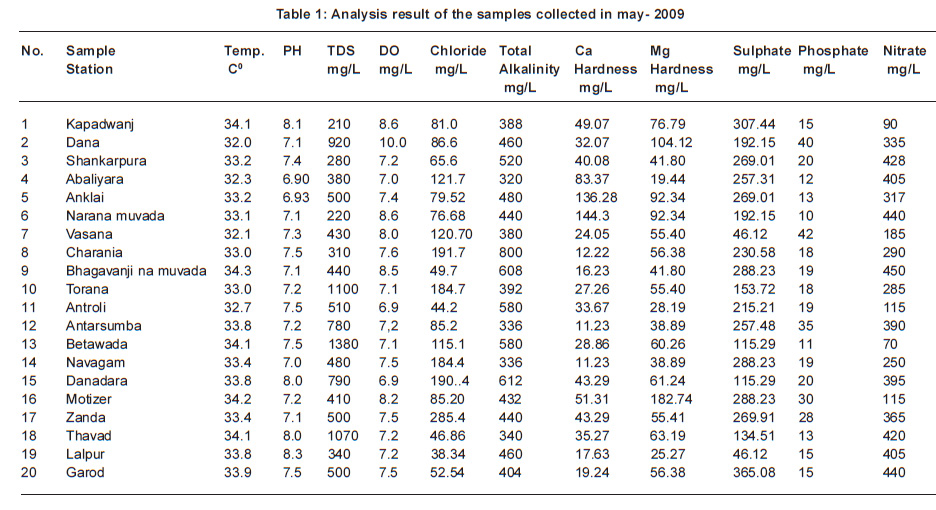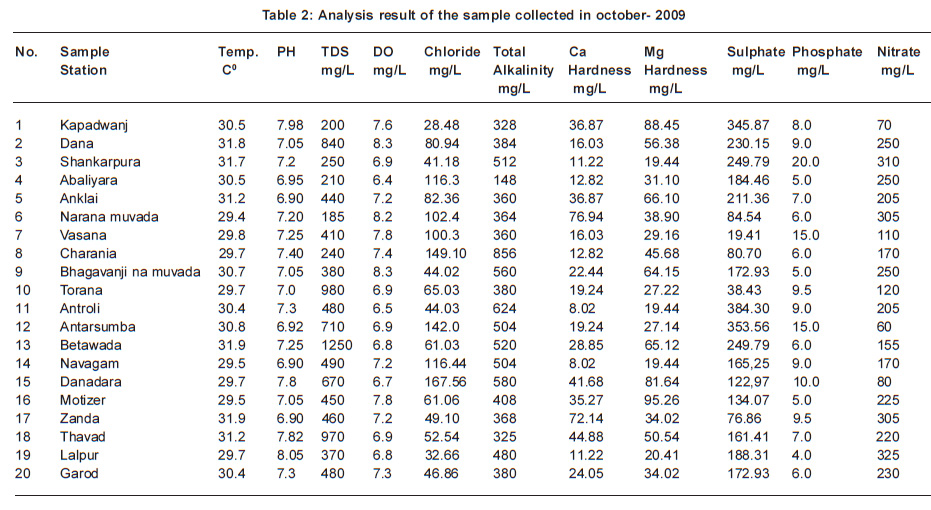Physico-chemical analysis of borewells drinking water of Kapadwanj territory
S.N. Pandya1 * , A.K. Rana1 and D.K. Bhoi2
1
Department of Chemistry,
J and J College of Science,
Nadiad,
387 001
India
2
Navjivan Science College,
Dahod,
389 151
India
DOI: http://dx.doi.org/10.12944/CWE.5.2.05
Physico-chemical analysis such as temperature , pH, dissolved oxygen, total dissolved solids, chloride, total alkalinity, calcium and magnesium hardness, sulphate, phosphate, nitrate of bore wells water was carried out from twenty sampling stations of Kapadwanj territory area during the May - 2009 and October - 2009 in order to assess water quality index.
Copy the following to cite this article:
Pandya S. N, Rana A. K, Bhoi D.K. Physico-chemical analysis of borewells drinking water of Kapadwanj territory. Curr World Environ 2010;5(2):253-257 DOI:http://dx.doi.org/10.12944/CWE.5.2.05
Copy the following to cite this URL:
Pandya S. N, Rana A. K, Bhoi D.K. Physico-chemical analysis of borewells drinking water of Kapadwanj territory. Curr World Environ 2010;5(2):253-257. Available from: http://www.cwejournal.org/?p=1187
Download article (pdf)
Citation Manager
Publish History
Select type of program for download
| Endnote EndNote format (Mac & Win) | |
| Reference Manager Ris format (Win only) | |
| Procite Ris format (Win only) | |
| Medlars Format | |
| RefWorks Format RefWorks format (Mac & Win) | |
| BibTex Format BibTex format (Mac & Win) |
Article Publishing History
| Received: | 2010-08-15 |
|---|---|
| Accepted: | 2010-09-23 |
In continuation of our earlier analysis on Bore wells water,1-3 here we report the Physico-Chemical analysis of Bore wells drinking water of kapadwanj territory. Kapadwanj is located in Kheda District of Gujarat. Borewells water is generally used for Drinking and other domestic purposes in this area. The use of fertilizers and pesticides, manure, lime, septic tank, refuse dump, etc. are the main sources of Borewells water pollution.4 In the absence of fresh water supply, people residing in this area forced to use Bore wells water for their domestic and drinking consumption. In order to assess water quality index, we have carried out the Physico-Chemical analysis of Bore wells drinking water.
Experimental
In the present study Bore wells water samples from twenty different areas located in and around Kapadwanj territory were collected in brown glass bottles with necessary precautions.
Physico-chemical analysis
All the chemicals used were of AR grade. Double distilled water was used for the preparation of reagents and solutions. The major water quality parameters considered for the examination in this study are temperature, pH, dissolved oxygen (D.O.), total dissolved solid (T.D.S.), total alkalinity, calcium and magnesium hardness, sulphate, phosphate and nitrate contents.6
Temperature, pH, D.O., TDS, Phosphate, Nitrate values were measured by water analysis kit and manual methods. Calcium and Magnesium hardness of water was estimated by complexometic titration methods.7 Chloride contents were determined volumetrically by silver nitrate titrimetric method using potassium chromate as indicator and was calculated in terms of mg/L. Sulphate contents were determined by volumetric method.7
Results and Discussion
The Physico-Chemical data of the Bore wells water samples collected in May-2009 and October-2009 are presented in Table-1 and Table-2 respectively. The results of the samples vary with different collecting places because of the different nature of soil contamination.7 All metabolic and physiological activities and life processes of aquatic organisms are generally influenced by water temperature.
  |
Table 1: Analysis result of the samples collected in may- 2009 Click here to view table |
  |
Table 2: Analysis result of the sample collected in october- 2009 Click here to view table |
Temperature
In the present study temperature ranged from 29.4o C to 34.3o C.
PH
In the present study PH ranged from 6.9 to 8.3 which lies in the range prescribed by APHA8 The PH value of drinking water is an important index of acidity, alkalinity and resulting value of the acidic-basic interaction of a number of its mineral and organic components. PH below 6.5 starts corrosion in pipes. Resulting in release if toxic metals in. The tolerance PH limit is 6.5 to 8.5.
TDS
In the present study TDS ranged from 185 mg/L to 1380 mg/L. According to WHO 9 and Indian standards TDS values should be less than 500 mg/ L for drinking water. All the sample station except sample station no 2, 10, 12, 13, 15, 18 higher ranged as prescribed by WHO and Indian standard.10
D.O.
In the present study dissolved oxygen (D.O.) ranged from 6.4 to 10 mg/L. The minimum tolerance range is 4.0 mg/L for drinking water.
Chlorides
The chlorides contents in the samples between 28.48 mg/L to 285.40 mg/L Natural water contains low chloride ions. In the present study sample station No. 18 shows 285.40 mg/L chloride. Which is highest value in twenty different sampling station. The tolerance range for chloride is 200-1000 mg/L.10
Total Alkalinity
In the present study total alkalinity ranged from 148mg/L to 856 mg/L.
Calcium Hardness
The Calcium hardness ranged from 8.02-3mg/L The tolerance range for calcium hardness is 75 - 200 mg/L. Calcium contents in all samples collected fall within the limit prescribed. Calcium is needed for the body in small quantities, though water provides only a part of total requirements.11
Magnasium Hardness
Magnesium hardness ranged from 19.44 -182.74 mg/L. The tolerance range for Magnesium is 50 - 100 mg/L
Sulphate
Sulphate ranged from 19.41 mg/L to 384.30 mg/L. The tolerance range for sulphate is 200-400 mg/L. The high concentrations of sulphate may induce diarrhoea.12
Phosphate
In the present study phosphate ranged from 4.0 mg/L to 42 mg/L. The evaluated value of phosphate in the present study are much higher than the prescribed values.13 The higher value of phosphate is mainly due to use of fertilizers and pesticides by the people residing in this area. If phosphate is consumed in excess, phosphine gas is produced in gastro-intestinal tract on reaction with gastric juice. This could even lead to the death of consumer.
Nitrate
In the present study Nitrate ranged from 60 mg/L to 450.0 mg/L. The tolerance range for Nitrate 20-45 mg/L. Nitrate nitrogen is one of the major constituents of organisms along with carbon and hydrogen as amino acids, proteins and organic compounds present in the bore wells water.14 In the present study nitrate nitrogen levels show higher values than the prescribed values.14 This may be due the excess use of fertilizers and pesticides in this area.
Acknowledgements
The Authors are thankful to the UGC for financial assistance in the form of Minor Research Project [F No. 47-511-2008[ WRO] Date: 2-2-2009] The Authors are also thankful to “The Nadiad Education Society, Nadiad and “The Principal of JJ College of Science,” Nadiad for providing necessary facilities.
References
- A.K.Rana, M.J.Kharodawala, J.M.Patel ,R.K.Rai B.S.Patel and H.R.Dabhi, Asian J. Chem, 14: 1209 (2002).
- A.K.Rana, M.J.Kharodawala , H.R.Dabhi ,D.M.Suthar ,D.N.Dave, B.S.Patel, ,R.K.Rai, Asian J. Chem,14: 1178 (2002).
- M.J.Kharodawala ,D.M.Suthar ,D.N.Dave, J.M.Patel, ,B.S.Patel R.K.Rai and. H.R.Dabhi, Orient. J. Chem. (2004)
- P.A.Hamilton and D.K.Helsel Ground Water, 332 (1995)
- E.Brown, M.W.Skovgstd and M.J. Fishman Methods for Collection and Analysis of water Samples for Dissolved Minerals and Gases,l 5 (1974)
- N.Manivasagam, Physico-chemicals Examination of water, Sewage and Industrial Effuents, Pragati Prakashan, Meerat (1984)
- A.I.Vogel,Text Book of Quantitative,Inorganic Analysis,4th Edn,ELBS, London (1978)
- APHA; American Public Health Association . Standard methods for Examination of water and waste water,16th Edn APHA –WPCE –AWWA,Washington.(1985).
- International Standard for drinking water,3rd Edn WHO Geneva (1971)
- The Gazette of India ;Extraordinary ,part- II , 3,11 (1991)
- A.J.Dhembare, G.M.Pondhe and C.R.Singh. Poll.Res; 17: 87 (1998)
- J.E.Mekee and H.W.Wolf, Water Quality Criteria. The Resourses Agency of California State water Quality control Board.(1978)
- APSFSL, Andhra Pradesh State Forensic Science Laboratories, Annual Report (1988).
- D.G.Miller,Nitrate in Drinking Water ,Water Research Center,Medmenham (1981).
- NEERI;National Envirnment Engineering Research Institute,Disiafection of Small Community Water Supplies, Nagpur.(1972)B.H.Mehta and M.B.Mehta Asian.J. Chem,12: 122 (2000)
- B.H.Mehta and M.B.Mehta Asian.J. Chem, 12: 122 (2000)
- S.Ghoshal, S.S.Dedalal and S.C.Lahiri J. Indian.Chem. Soc. 81: 318(2004)
- J.W.White ,J.Agri. Food Chem,23, 886 (1975)
- S.S.Dara, Envirnmental Chemistry and Pollution Control ,S.Chand & Company ,New Delhi.P-356 (2004).






